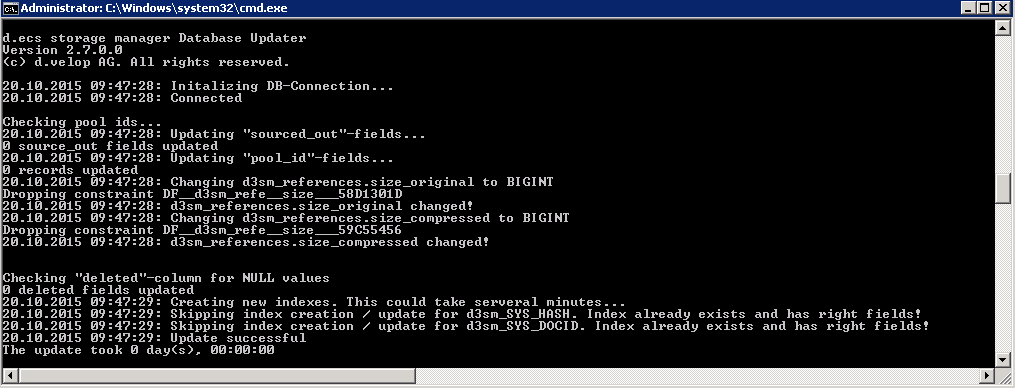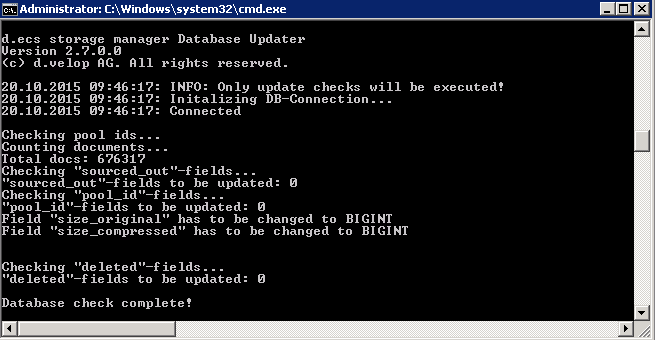Installing updates for d.ecs storage manager with d.velop software manager
You can only update the software using d.velop software manager.
For further information on updates, see the d.velop software manager manual.
Note
If an older version of d.3 or d.ecs storage manager is already installed, create a backup of your configuration files before installing.
Running a database update after installing an update
As the table structures of the d.ecs storage manager tables may have changed during updates of the software, d.ecs storage manager may update the table structures when starting a new version for the first time and continue the start process afterwards.
If the automatic update is aborted due to an error, this will be logged in the d.3 logfile and additionally sent to d.ecs monitor. In this case, the program for updating the table structures must be run manually to perform further analysis.
The update program named DBUpdater.exe checks the table structure and the indexes and adapts them for the new version if necessary.
You can find the program in the d.ecs storage manager application directory. It uses the configuration file (ini file) of d.ecs storage manager to log in to the database.
The program has to be executed as follows:
DBUpdater.exe <ini-configuration file of d.ecs storage manager>
The program then returns messages like this:
 |
If you are prompted to select an archive ID, then you must select the main archive ID of the archive here.
To determine the steps to be executed as part of a table update, the DBUpdater can be started with the parameter /CHECKONLY.
DBUpdater.exe <ini-configuration file of d.ecs storage manager> /CHECKONLY
The program then returns messages like this:
 |
Note
Adjusting the d.ecs storage manager tables may take a while for large volumes of data as new fields may have to be added and (for existing data) may have to be filled with values. Please plan for a down-time of the d.ecs storage manager for this respect. Should you still have reference entries of old, no longer existing systems in the reference table of the d.ecs storage manager, then these should be deleted before the update to reduce the data volume pending to be updated. Please contact the d.velop support if necessary.
Note
Also make sure that you have sufficient table space for the changes. If the DBUpdater is aborting due to database errors (such as lack of disk space), it can be started again after having resolved the problem.
The DBUpdater executes the following steps on the table d3sm_references:
Check of the column sourced_out
Check of the column sourced_out_time
Check of the column pool_id
Check of the columns size_original and size_compressed
Check of the column reference
Check of the column signature_cid
Check of the column volume_id
Check of the column system_check_result
Checking the column evidence_state
Check of the column delete_token
Check of the column reference_index
MSSQL: The field is created and directly populated with values, a unique index is generated.
DB2: The field is created with default 0, the default is dropped, the default is set to IDENTITY, the field is set to DEFAULT in blocks of 100,000, a unique index is generated.
DB2/400: The field is created and directly populated with values.
Oracle: The field is created, a sequence is created, the field is populated in blocks of 100,000 via the sequence, a unique index is generated.
Check of the column retention_on_storage
Check of the column deleted
Change of the column job_date in the table decssm_jobs from DATE to TIMESTAMP (only DB2 and DB2/400)
Check of the index d3sm_sys_hash
Check of the index d3sm_sys_docid
Check of the index d3sm_sys_delete
Check of the index d3sm_sys_ref
Check of the index d3sm_sourced_out
Check of the table d3sm_version
Note
Please execute the following additional steps:
Open the administration interface and save the configuration there. This is necessary to confirm the now configurable DB-Filegroups.
At the first update via d.velop software manager: Adjust the call parameters for d.ecs storage manager in the d.3 process manager.